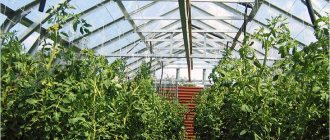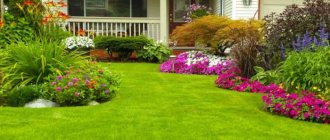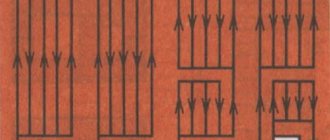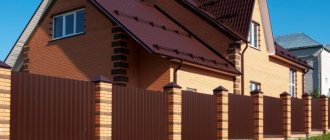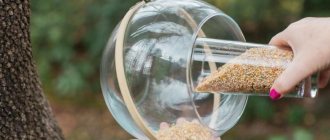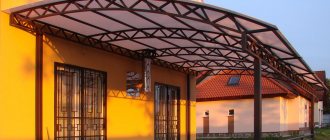Requirements for a homemade greenhouse
First of all, the future owner of the structure needs to determine what the greenhouse will be like:
- Quite voluminous, but at the same time, compact structure. Modern summer cottages are not pleasing with the available free space, which means that square meters need to be saved.
- For optimal organization, it is better to make several tiers in the greenhouse, on which plants are placed in large boxes. On the lowest floor you can fill up entire soil areas for tomato bushes and climbing cucumber crops.
- Sufficient level of natural and artificial lighting. After daylight hours end, many plants require additional lighting. In order to save energy and at the same time provide sufficient lighting, you can use fluorescent lamps (energy-saving option).
- Durable frame. Today, there are both mobile and stationary models of greenhouses. However, in regions with an unstable climate, preference should be given to stationary types of structures with a reliable frame.
- Preservation of natural air circulation in the room. Constant renewal of air allows plant crops to grow in better conditions, with a sufficient level of oxygen supply.
- The material used to cover the prepared frame must dissipate the harmful spectrum of sunlight. All types of polycarbonate have these characteristics.
When preparing a drawing, you should definitely calculate the possibility of connecting communications (water supply, electricity, heating) to the greenhouse. During assembly of the product, it is necessary to ensure that the structure is as tight as possible.
Drafts and cold air can damage young plants within a few hours. The best DIY greenhouse projects from A to Z can be found on practical gardening web resources.
Quarantine zone
The arrangement of the greenhouse inside should have a small area on which individual groups of plants will be placed. Its main function is to protect “guests” from possible infection or pests. Seedlings that raise suspicions are placed here. For example, bought in a store, the quality of which is still unknown to you.
Quarantine zone behind glass Source teplicivomske.ru
Useful little things applicable for the quarantine zone in a greenhouse:
- A transparent, light-transmitting barrier from the rest of the space. For example, use a glass box or an aquarium.
- Placement on a rack, which minimizes the likelihood of infection entering the soil.
This is what the absence of a quarantine zone leads to Source teplicivomske.ru
Healthy! The quarantine size is determined depending on the size of the greenhouse and the number of seedlings you purchase.
Choosing an installation location
An important criterion that should be given special attention is the installation location of the future greenhouse. For independent work, stationary models are most often chosen. The site selected for the location of greenhouses must meet a number of characteristics:
- Do not contain underground currents located in the upper layers.
- Be located far enough from latrines and livestock burial sites.
- Should not contain karst voids.
Before starting work, the site is thoroughly cleared of debris and weeds. Check the acidity level of the soil and, if necessary, fertilize the soil until the desired values are obtained. A similar procedure is not required if a concrete base is laid on top of the ground.
Care
All parts of dismantled structures must be cleaned of dirt and dust at the end of the season. To do this, you can use a solution of potassium permanganate or mustard. After this, they are thoroughly dried and stored in a dry room protected from precipitation.
In the case of stationary structures (with a foundation, glass or polycarbonate), seasonal maintenance should be carried out more thoroughly.
To prevent the proliferation of pests, the walls of the greenhouse are treated with a solution of potassium permanganate, the old soil is removed by 10-15 cm, after which new soil is added, and ash, sand, humus, and sometimes wood are added to it. Then it is carefully dug up and treated with a sulfur bomb.
The greenhouse, ready for the new season, is left open until the onset of frost or until the first snowfall. In winter, it is advisable to close the greenhouse tightly to protect it from snow and gusts of wind.
It will be useful to leave some snow in the greenhouse. In spring, melt water can have a beneficial effect on soil quality. In case of heavy snowfalls, the greenhouse must be cleaned with a shovel or broom; in case of moderate precipitation, it can be left alone.
Tools and materials for work
To begin the construction process, you need to prepare the following set of materials and tools:
- Grinder and welding for working with the frame.
- Cement, sand, gravel for laying the foundation.
- Wooden boxes of sufficient depth and width to organize unpaved areas.
- Wooden or metal parts for mounting shelves.
- Polycarbonate or other materials for covering the prepared frame.
- Fasteners (screws, self-tapping screws, nails, thermal washers).
- Rotating fittings for mounting doors, vents and ventilation hatches.
- DIY greenhouse drawings.
You will also need barrels for settling water, hose systems for organizing drip irrigation, and trellises for stretching climbing crops. For heated buildings, you can choose a traditional wood-burning firebox, an electric stove or an air “gun”.
Choice of material for the frame
First of all, the master must choose the material for making the frame. This can be either purchased material or a lot of improvised means. The following types of frames are most optimal for work:
- Metal frame (both sheet material and reinforced iron will be relevant in the work).
- Do-it-yourself greenhouses made of PVC pipes.
- Wooden slats.
It is most rational to use these materials in your independent activities. All parts are absolutely safe, have adequate strength and durability.
Greenhouse-breadbox
This type of greenhouse is so called because of its clear resemblance to a bread box. The double-leaf design allows you to care for the planted crop without any hassle. A greenhouse bread bin can be assembled from any material, but most often profile pipes are used as a frame.
Polycarbonate is used as a coating. In the greenhouse, as mentioned earlier, there are two doors, and they should open towards each other.
Reinforced iron frame
For quality work, you need skills in handling welding and a grinder. The metal frame is very strong, resistant to moisture (if pre-coated with an anti-corrosion compound), capable of holding a significant weight of snow in winter and wind in the off-season. It is easy to mount polycarbonate sheets to the metal frame using thermal washers.
Note!
The staircase to the second floor in a private house is an example of beautiful design. Layout diagrams, instructions, layout + photos- Beautiful private houses - the best ideas and examples of beautiful home design. Photos of the coolest ideas of 2021!
The best ideas for a summer house | Review of stylish and original solutions for country houses and cottages
Wood for frame construction
Wood should be selected for work only after pre-treatment with moisture-resistant compounds. In addition, it is imperative to assess the condition of the parts before assembling the structure - for damage, cracks, and pest passages.
An antipyretic layer will reduce the risk of fire. Greenhouses made of wood covered with film are quite easy to assemble with your own hands using step-by-step instructions.
Types of greenhouses
There are a huge number of options for what you can make a greenhouse from: it all depends on the gardener’s imagination and the available materials, as well as the expected size. After all, if you wish, you can even cut holes in the barrel, which can then simply be tightly covered with film so that warm air does not escape.
In addition, some craftsmen manage to simply adapt a wooden box and make a simple lid, which consists mostly of glass or film to transmit ultraviolet radiation.
Here's another interesting example: for a couple of single small plants, an umbrella with transparent material was simply carefully stuck in, which does its job perfectly.
However, it is still better to make one high-quality greenhouse that you are not ashamed to show to your neighbors. In these photos, the greenhouses are made with your own hands.
And it doesn’t matter at all what the greenhouse is made of: either from a profile pipe or from wood. The main thing is that it is strong and stable. And then properly cover it with any transparent material discussed earlier, so that warm air does not escape beyond the structure itself without the knowledge of the owners.
Therefore, further we will consider the main types of greenhouses, as well as methods of construction.
Polycarbonate sheets
Polycarbonate has a particularly durable structure and creates an excellent protective layer from the scorching rays of the sun. Cellular polycarbonate, which diffuses sunlight, deserves special attention.
As a result, the spectrum of ultraviolet radiation, which is harmful to plant crops, is eliminated. Do-it-yourself polycarbonate greenhouses are durable and extremely practical.
Heating system
It is impossible to predict what the weather will be like throughout the season. Therefore, it is recommended to take care of ensuring optimal temperature conditions inside the greenhouse ahead of time. This issue becomes especially relevant in the spring - at the planting stage and in the fall, with the onset of cold weather.
The air is heated by a long chimney Source www.oblgazeta.ru
Heating a greenhouse with plastic bottles Source yandex.ru/images/_
There are several ways to heat a greenhouse from the inside.
Oil-filled household heater. One of the simplest heating methods. The only problem may be the availability of a constant current source to connect it. The number of radiators is determined depending on the size, thermal insulation characteristics of the structure and temperature changes.
Infrared heaters for greenhouses Source retete-usoare.eu
Infrared heater. Works on the principle of oil ones, but with greater efficiency. This is explained by the fact that the latter emit light useful for plant growth. This technique will also require running electricity.
The popular method is to heat a greenhouse from the inside with plastic bottles. Water is collected into them, after which the containers are laid out around the entire perimeter. During the day, the liquid heats up in the sun, and in the evening and at night it releases thermal energy, warming up the room. Because of this feature, this technique is more suitable for use in the spring, when there are clear, sunny days. In rainy autumn, the effect of bottles will be small.
The most labor-intensive greenhouse heating system Source infracom74.ru
One of the most effective methods of heating the inside of a greenhouse is to create a “warm ground”. The method is quite labor-intensive, but effective. To do this, a layer of soil is removed, extruded polystyrene foam is laid, elements responsible for heating are laid on it: a heated floor cable, pipes through which hot water will circulate, then everything is sprinkled with sand, and the top is covered with the removed soil. The system can operate on electricity, gas, wood, coal - depending on the boiler you have installed.
Important! When using cable heating, you will not need a boiler. It will be replaced by a thermostat.
Installation of radiators, thermal mats and metal heating pipes can also take place around the perimeter of the greenhouse, without labor-intensive excavation work.
Arrangement of the greenhouse from the inside Source images.ru.prom.st
Healthy! Another old-fashioned but effective way to heat a greenhouse is to use herbal compost. For this you can use hay, dry weeds, straw, humus. As a result of fermentation, the plants will begin to “burn”, releasing heat, thereby warming up the surrounding air.
Window frames
After replacing old wooden windows with new plastic models, you should not recklessly throw away the frames with glass. Such designs are ideal for arranging a full-fledged greenhouse.
Glass does not protect plants from sunlight, but this defect can be easily corrected by covering the glass with a special film. Double frames have particular advantages, between which heat is well retained.
DIY greenhouse assembly
Having decided on the basic materials, you can begin assembling the structure. Initially, a drawing is prepared that shows the dimensions of the future structure, the foundation (if provided for this model), all support posts, doors, and ventilation hatches.
You can do the greenhouse project yourself, or use a ready-made plan. Separately, in the second drawing you can display the layout of electrical wiring, outlet points and arrangement of lighting and heating devices.
If there is a motor or pump for drip irrigation, its location is also displayed on the plan diagram. Further work is carried out according to the following instructions on how to make a greenhouse with your own hands:
- After clearing the prepared soil area, the foundation (strip or pillar) is poured; otherwise, the soil can be covered with soil.
- During the solidification process of the foundation, its surface is periodically moistened with water to prevent the appearance of cracks.
- After a few days, you can begin assembling the frame from the selected material. Reinforced iron is secured using welding. For PVC pipes, cold welding and additional clamps are useful. Wooden parts are secured using self-tapping screws or self-tapping screws.
The next step is the installation of polycarbonate sheets, polyethylene film or old window frames. Be sure to check the reliability of fastening and the quality of sealing. Install doors and ventilation hatch covers.
Next, you should deal with the internal arrangement of the greenhouse: installing tiers, shelves, trellises for climbing plants. High-quality operation of the greenhouse for plants can be ensured by following each stage of the prepared work plan. Also, if you lack experience, you can watch video tutorials on creating a homemade greenhouse.
What do you plan to grow in the warm weather?
Based on what crops are supposed to be grown and in what quantities, you should understand what size the greenhouse should be.
After all, greenhouses are divided into two types according to the mobility of the structure:
- Portable
- Stationary
This is a matter of taste, but installing a temporary greenhouse or building a portable one is much easier.
Once it has been possible to determine the planting area, as well as the expected height of the crops, we can judge the future dimensions. When this issue is resolved, it is worth considering the next point.
